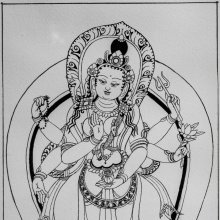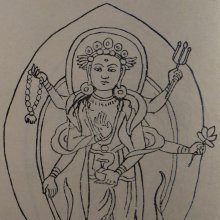Sugatisamdarshanalokeshvara, Sugatisamdarshana-lokeshvara, Sugatisaṃdarśanalokeśvara, Sugatisandarśanalokeśvara, Sugatisandarshanalokeshvara, Sugatisandarshana-lokeshvara: 2 definitions
Introduction:
Sugatisamdarshanalokeshvara means something in Buddhism, Pali, Hinduism, Sanskrit. If you want to know the exact meaning, history, etymology or English translation of this term then check out the descriptions on this page. Add your comment or reference to a book if you want to contribute to this summary article.
The Sanskrit terms Sugatisaṃdarśanalokeśvara and Sugatisandarśanalokeśvara can be transliterated into English as Sugatisamdarsanalokesvara or Sugatisamdarshanalokeshvara or Sugatisandarsanalokesvara or Sugatisandarshanalokeshvara, using the IAST transliteration scheme (?).
Images (photo gallery)
In Buddhism
Tibetan Buddhism (Vajrayana or tantric Buddhism)
Source: archive.org: The Indian Buddhist Iconography1) Sugatisandarśanalokeśvara (सुगतिसन्दर्शनलोकेश्वर) or simply Sugatisandarśana refers to one of the various forms of Avalokiteśvara having their Sādhana described in the 5th-century Sādhanamālā (a collection of sādhana texts that contain detailed instructions for rituals).—His Colour is white; he has six arms.—One short Sādhana in the Sādhanamālā describes this form [viz., Sugatisandarśanalokeśvara] of Avalokiteśvara.
2) Sugatisandarśanalokeśvara (सुगतिसन्दर्शनलोकेश्वर) or simply Sugatisandarśana refers to number 16 of the 108 forms of Avalokiteśvara found in the Machhandar Vahal (Kathmanu, Nepal). [Machhandar or Machandar is another name for for Matsyendra.]. [...]The names of the 108 deities [viz., Sugatisandarśanalokeśvara] possbily originate from a Tantra included in the Kagyur which is named “the 108 names of Avalokiteshvara”, however it is not yet certain that this is the source for the Nepali descriptions. Tibetan Buddhism includes schools such as Nyingma, Kadampa, Kagyu and Gelug. Their primary canon of literature is divided in two broad categories: The Kangyur, which consists of Buddha’s words, and the Tengyur, which includes commentaries from various sources. Esotericism and tantra techniques (vajrayāna) are collected indepently.
Languages of India and abroad
Sanskrit dictionary
Source: Cologne Digital Sanskrit Dictionaries: Edgerton Buddhist Hybrid Sanskrit DictionarySugatisaṃdarśanalokeśvara (सुगतिसंदर्शनलोकेश्वर).—name of a deity: Sādhanamālā 88.14, 19.
Sanskrit, also spelled संस्कृतम् (saṃskṛtam), is an ancient language of India commonly seen as the grandmother of the Indo-European language family (even English!). Closely allied with Prakrit and Pali, Sanskrit is more exhaustive in both grammar and terms and has the most extensive collection of literature in the world, greatly surpassing its sister-languages Greek and Latin.
See also (Relevant definitions)
Partial matches: Lokeshvara, Sugatisandarshana.
Full-text: Sugatisandarshana.
Relevant text
Search found 1 books and stories containing Sugatisamdarshanalokeshvara, Sugatisamdarshana-lokeshvara, Sugatisaṃdarśanalokeśvara, Sugatisandarśanalokeśvara, Sugatisandarshanalokeshvara, Sugatisandarshana-lokeshvara, Sugatisamdarsanalokesvara, Sugatisaṃdarśana-lokeśvara, Sugatisandarśana-lokeśvara, Sugatisandarsanalokesvara, Sugatisamdarsana-lokesvara, Sugatisandarsana-lokesvara; (plurals include: Sugatisamdarshanalokeshvaras, lokeshvaras, Sugatisaṃdarśanalokeśvaras, Sugatisandarśanalokeśvaras, Sugatisandarshanalokeshvaras, Sugatisamdarsanalokesvaras, lokeśvaras, Sugatisandarsanalokesvaras, lokesvaras). You can also click to the full overview containing English textual excerpts. Below are direct links for the most relevant articles:


.jpg)